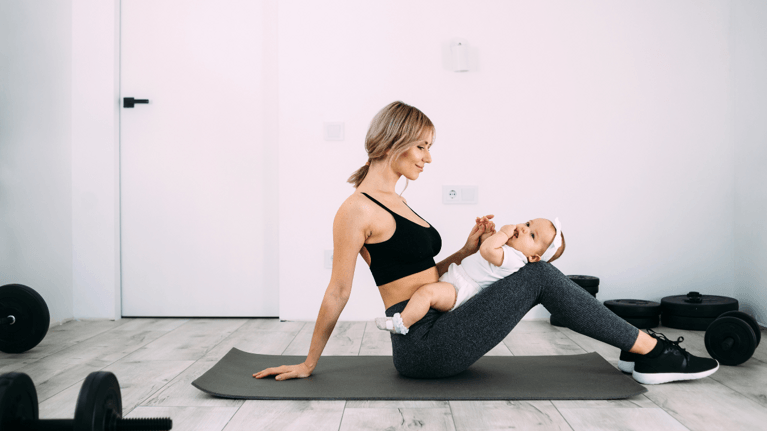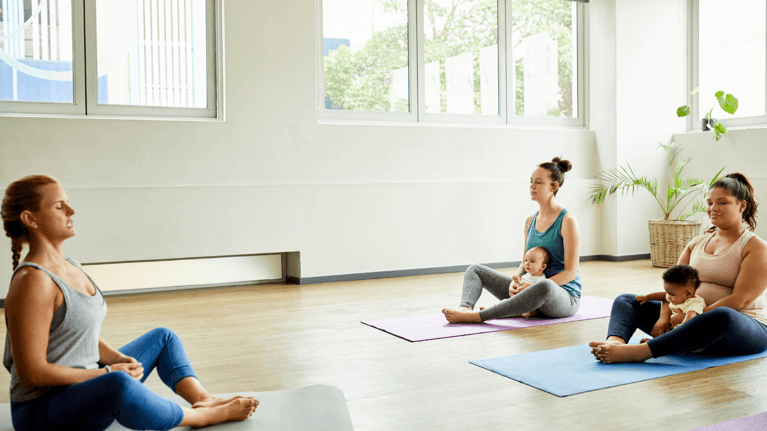What are the Best Postpartum Core Exercises?
How to safely strengthen your core postpartum with four of the best exercises

iStock
Building core strength is key to improving your health and well-being during your postpartum recovery. While strengthening all your muscles is recommended, focusing on your abdominal exercises is particularly important as a new mom to help prevent back pain, improve your balance, and support a faster return to baseline fitness levels.
A strong core post-pregnancy will also help support you in your daily tasks as a mom, such as feeding, lifting your baby, and carrying heavy equipment such as a car seat or stroller.
What are the core muscles?
The abdominal muscles can be divided into two parts: the inner core and the outer core. The inner core includes muscles like the transverse abdominus, pelvic floor muscles, and diaphragm. These muscles help with balance, stability, controlling abdominal pressure, proper breathing technique, and supporting pelvic organs.
The outer core includes your obliques and rectus abdominus muscles, which are important for posture, movement, breathing, abdominal pressure, and protecting your abdominal organs.

How do I safely strengthen my core postpartum?
Follow these tips to strengthen your core safely post-pregnancy:
-
Get checked by your primary care provider to ensure your body has healed and that it is safe to exercise.
-
Gradually increase the difficulty of your exercises. You should make your core exercise more challenging when a movement feels easy.
-
Listen to your body. If something doesn’t feel right for you, don’t do it. Watch for any red flag symptoms which suggest you should stop or modify an exercise.
-
It might be too strenuous if you notice your stomach forming a dome-like shape during an exercise. Modify the exercise or choose a different one with lower intensity.
-
Consider seeing a pelvic floor physical therapist or a qualified exercise professional to help you with an effective postpartum workout plan.
What should I do if I have diastasis recti?
During pregnancy, your belly stretches to make room for your growing baby. This can create a gap between your abdominal muscles and diastasis recti. However, don't worry; this is a common and normal occurrence during and post-pregnancy.
If you think you might have diastasis recti, it is important to strengthen your core muscles safely. Use the tips above to build strength, improve function, and prevent injury. If you feel any physical or emotional discomfort due to your gap, consider speaking with a healthcare professional for an individualized assessment and guidance.
What are the best core exercises to do postpartum?
Core Connection Breath
The core connection breath is a great exercise to learn how to connect to your pelvic floor and transversus abdominus muscles. To begin, try this exercise while lying on your back. Breathe in and let your stomach and ribs expand.
At the same time, allow your pelvic floor and core muscles to relax. Next, exhale and gently lift your pelvic floor muscles.
This should feel as if you’re stopping a flow of urine and gas from passing.
Repeat this exercise 3-5 times and try it in various positions, including sitting, on all fours, and standing.
Core Marches
Begin by lying on your back with your knees bent and feet flat on the floor. Inhale and relax your pelvic floor and core muscles. Then, exhale while gently lifting your pelvic floor muscles and engaging your core.
Keeping your core engaged, slowly raise one leg towards your chest and lower it back down. Repeat on the other side, alternating legs as if you are marching in place while lying down. Repeat this exercise eight to 10 times per leg.
Deadbugs
Lie on your back with your knees bent at a 90-degree angle (tabletop position with shins parallel to the floor) and your arms straight up above your chest. Activate your core and pelvic floor muscles using the core connection breath.
Then, lower your right arm and left leg toward the floor simultaneously without letting them touch the ground. Bring them back to the starting position and repeat on the other side. Repeat this exercise eight to 10 times per leg.
Plank Variations
Plank variations are fantastic for boosting your core strength. A wall plank is a great starting exercise. To do this, stand facing a wall and place your hands on the wall a bit wider than your shoulders.
Step your feet a few steps away from the wall, keeping your body straight while leaning toward the wall. Engage your core and hold this position for 20-30 seconds.
Once this exercise feels easy, try planking on a bench instead of the wall for an added challenge. Gradually progress to a knee plank on the ground and, eventually, a full plank on your toes.
Knowing how to strengthen your core muscles postpartum can help you feel healthier and more confident as a new mom. Remember, the key is to progress at your own pace and increase the difficulty level when the exercise feels easy. This gradual approach ensures a safe and effective rebuild of core strength during your postpartum journey.
FAQs
How soon after birth can you start exercising?
Usually, the earliest you will be cleared to return to exercise is six weeks after delivery. However, this varies from person to person, so make sure to check with your healthcare provider.
If you had an uncomplicated vaginal delivery, you may be able to begin gentle exercises like walking or pelvic floor exercises within a few days to weeks after your delivery. If you delivered via C-section, it may take longer for your incision to heal.
Consult your healthcare provider for specific guidance before starting any exercise regimen postpartum. They can assess your individual situation and provide recommendations based on your unique circumstances.
What types of exercises should be avoided postpartum?
While exercise is essential for postpartum recovery, some exercises should be avoided or modified to prevent injury or discomfort when first returning to exercise. Here are some exercises to steer clear of or modify:
- High-Impact Exercises: Avoid high-impact exercises like running or jumping in the early weeks postpartum, as they can put excessive stress on your pelvic floor and abdominal muscles. Instead, opt for low-impact activities like walking, swimming, or stationary cycling, as well as low-impact strength training.
- Sit-Ups: Traditional sit-ups can put excessive strain on your core and pelvic floor muscles. Focus on alternative core exercises at first, such as those listed above.
- Heavy Lifting: Lifting too much weight too soon may lead to injury and pelvic floor dysfunction. Start with bodyweight exercises and lighter weights, and slowly build your way up.
Always prioritize your comfort and well-being. If any exercise causes pain, discomfort, or feels too strenuous, stop and consult your healthcare provider or a qualified exercise professional for guidance on suitable modifications.
Note: This post is for educational purposes only and does not replace medical advice or treatment from your healthcare provider. Always follow the advice of your primary care provider when making decisions about your health and well-being.
Author:
Jenni founded Jenni Diamond Health, an online platform that provides evidence-based exercise programs for new and expecting moms and birthing individuals. Jenni’s programs help moms and birthing individuals exercise safely during pregnancy and gain postpartum strength, confidence, and energy.
Weekly Newsletter
Keep up with your baby's development, get the latest parenting content and receive special offers from our partners